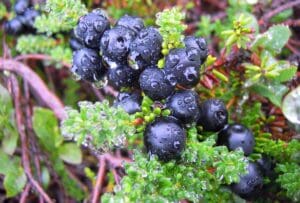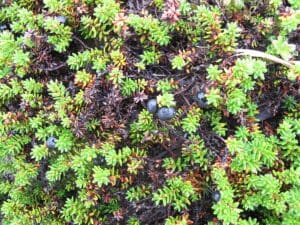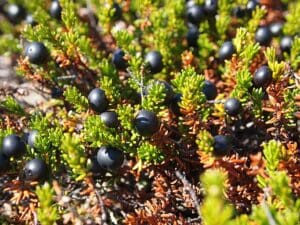Crowberry / Summer / Autumn / Winter / Edible
Foraging for wild edibles can be a delightful and rewarding experience, especially when you stumble upon lesser-known gems like the wild Crowberry. Known scientifically as Empetrum nigrum, this hardy berry thrives in the cool, temperate climates of the UK, offering a unique treat for those who know where to look.
In this guide, we’ll delve into the identifying features of wild Crowberries, their habitats, and their culinary uses.
Common names
Crowberry, Crawberry, Crawcrooks, Lingberry, Deer’s Grass, Moss berry
Botanical Name
Empetrum nigrum
Scientific Classification
Kingdom – Plantae
Order –Ericales
Family – Ericaceae
Physical characteristics of Crowberry
Stem
Reddish. Grows low to the ground, around 10-30cm in height.
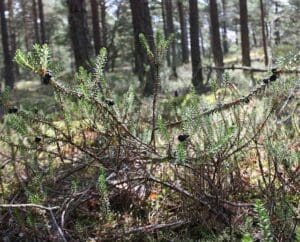
Leaves
Look a bit like mosses or tiny Pines, but they are fleshy, succulent and glossy. Light green and spiralling alternately along the stems in whorls. Around 5mm in length, with no stalk. Pale, hairy stripe on the lower surface.
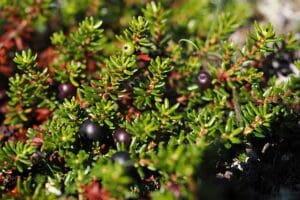
Flowers
Small and pink/ magenta, with three petals, three sepals and three stamens. Blooming in spring and summer.
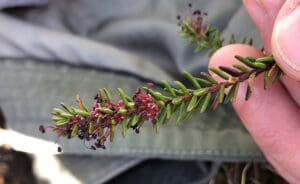
Fruit
Pea-sized berries grow in clusters along the stem. They start pink, turning to red/ purple and then to black as they ripen towards autumn time. They each have a divot on the bottom.
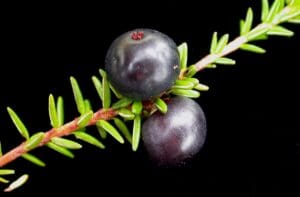
Habitat
Cool regions of North America, Asia, and Europe.
Damp and acidic soil of moorland, bogs and uplands.
Known hazards
Produces toxic substances from glands in the leaves which are released into the soil when they decompose.
Could be confused with
Bilberries, which can grow in the same environment. Bilberries often show the remains of the flower surrounding a tiny “’cog wheel” on the end of the berry, whereas crowberries lack this “cog wheel” form. They also have very different leaves.
The leaves of crowberry could be confused with some members of the Stonecrop species but these don’t have black berries growing along the stem.
Edible uses
Crowberries can be eaten raw but the flavour is acrid. The flavour is improved after a heavy frost or when dried or cooked.
They are used in pies, wine and jams.
They are an excellent source of antioxidants, vitamins C and K and fibre.
They also make a lovely Liquor
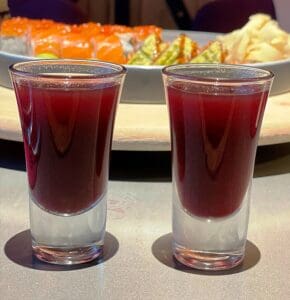
Notes on Herbal uses
Can be used for treatment of inflammation or bacterial and fungal infections. They lower cholesterol and can support the treatment of urinary tract and kidney diseases.
Crowberry extracts and juice have also been used in skincare, to support the maintenance of collagen and skin tone, owing to their high content of antioxidative substances, including phenolic acids, flavonoids and anthocyanins.
Please consider consulting a professional before embarking on any form of treatment.
Click here for our guide on making herbal remedies at home
Extra notes from the Foragers
In Finnish and Sami folklore, crowberries are associated with not crows but the raven, considered a wise and magically powerful bird.
Empetrum, comes from Greek meaning “growing on rocks”. Nigrum refers to the black colour of the berries.
Empetrum nigrum is in the Heather family. It sheds its leaves only once every two to four years.
It has been used as a fabric dye to give dark red colouring. Here’s a lovely image of dying with this berry



